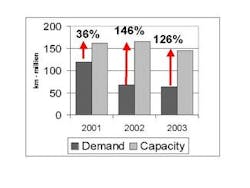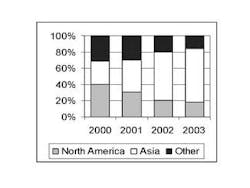More consolidation is required to balance supply and demand in optical fiber market, reports KMI Research
March 1, 2004 Providence, RI--The world's last optical fiber shortage ended in 2001 when demand peaked at 119 million km. Two years later in 2003 fiber shipments to cable manufacturers dropped by 47% to 63.5 million km. On the other hand, worldwide fiber-making capacity only decreased by 10% to 145 million km, down from 161 million km in 2001. The disparity between demand and capacity is shown in Figure 1. These findings are from KMI's newest report: Worldwide Optical Fiber and Cable Markets: Market Developments and Forecast, published in January 2004. KMI is a research division of PennWell, publisher of Lightwave.
According to the KMI report, this overcapacity has resulted in aggressive price competition. For the 47 fiber-manufacturing facilities that operated for at least part of 2003, average-capacity utilization for all facilities was less than 50%. This overcapacity meant the worldwide average price for conventional single-mode fiber fell from $35 per km in 2001 to a record low of $15 per km in 2003. The combination of lower prices for all types of fiber and lower unit-quantity shipments means that the market for bare fiber was $1.3 billion in 2003, down 75% from 2001.
The demand forecast shows that Asia will continue to be the largest regional market for cabled-fiber. Asia accounted for 66% of all cable-fiber demand in 2003, up from 29% in 2000. North America, however, fell from a 40% share in 2000 to an 18% share in 2003 as shown in Figure 2. What caused the sharp increase in demand and capacity in the late 90s only to see demand plummet in 2001 and 2002? And why has North America been displaced by Asia as the world's leading market for optical fiber?
Optical fiber has been the medium of choice for the world's telecommunication's network operators since the mid-1980s. It is more efficient and robust than the copper it replaced, and it allows more information/data to be transmitted, a technology ideally suited to the requirements of the Internet age.
Optical fiber is used in two general applications: telecom and non-telecom. Telecom refers to long-distance and local operators such as AT&T, MCI, Sprint, Verizon, SBC, and a host of other companies. Non-telecom traditionally involved CATV operators such as Time Warner Cable, Comcast, Cox, etc, utilities and other entities as well as private network operators (corporations) that use fiber for internal information and communication purposes.
Through most of the 1990s, telecom applications accounted for 70%-75% of all optical fiber deployed worldwide. With the advent of the network construction boom that began in 1999, telecom's share increased to 80%. Underlying that five-percent shift was a rapid increase in fiber demand. From 1999-2001, telecom applications totaled 195 million km, 142% greater than the 81 million km installed from 1996-1998.
The surge in telecom-related fiber deployments, driven chiefly by externally financed long-haul network construction in the U.S. and Europe, outstripped the industry's capacity to make optical fiber. This new capacity came on line just as the telecom boom ended. More bandwidth was now available to the market than needed, which led to price competition, which meant that new operators defaulted on debt payments used to finance their network construction. With the burst of the telecom bubble, cost cutting became paramount, and capital expenditure budgets for new construction in North America and Europe were reduced or eliminated.
This meant that North America, the world's most developed telecommunication's market, saw fiber demand drop by 72% in 2003 from peak deployments in 2000. The long-distance market has been saturated, metropolitan rings in and around major cities have been completed, and CATV operators needed less fiber as they had already built out their networks to offer Internet and telephony services. Meanwhile, China, a developing nation, has continued extensive deployments of optical fiber to upgrade its telecommunication's infrastructure. Japan, one of the major markets for optical fiber, is continuing deployment of fiber to promote fiber-to-the-home. Together these two countries accounted for 55% of all optical fiber installed in 2003.
Although Asia has become the world's largest market for optical fiber and has helped offset the decline in demand in both North America and Western Europe, further consolidation in the fiber industry is necessary to better balance supply and demand.

